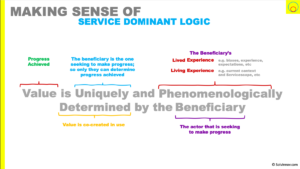Welcome to the Making SD-Logic Approachable Journey
Harnessing service-dominant logic in our innovation thinking opens up numerous opportunities. It frees us from counterproductive goods vs service thinking, opens up a more actionable definition of value and therefore innovation.
And is a powerful way to understand the way the world works, making us see collaboration and building relations as key. Suddenly jobs-to-be-done, blue ocean, experiences, agile etc all hang together and make sense.
However. The definitions of service-dominant logic can be unapproachable. Which leads to it being more of an academic study rather than practical real-world application it deserves to be.
In this journey we’ll look at demystifying the definitions.
First, we’ll re-order and group the foundational premises into the who, how and whats. And then look at each of those premises in turn.

In service-dominant logic, we see value differently to the traditional approach (where value is set by manufacturer and measured by the price paid - value-in-exchange). We see a beneficiary who is seeking to make progress in some aspect of their life. And they are hiring a service that proposes to help them make that progress.
Value is therefore only measurable by the beneficiary, and measures the amount of progress the beneficiary feel they have made
This measure is complicated by the baggage the beneficiary brings to the service - there lived experience. As well as the experience they have during the service provision - context, their mood, servicescape etc. Both this lived and living experience are phenomenological
We could interpret this foundational premise as the more approachable: Value is always uniquely determined by the beneficiary based on their lived and living experience


